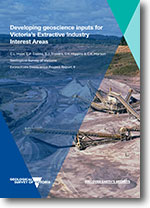EGPR 4 - Developing geoscience inputs for Victoria's Extractive Industry Interest Areas
 |
| |||||
Product description:Executive Summary:Extractive Industry Interest Areas (EIIAs) were originally developed by the Geological Survey of Victoria (GSV) over a ten-year period, beginning in the 1990s. Defining areas with the potential for quarry production provided a strategic planning tool to ensure the future supply of construction materials across Victoria by considering the geology, land use and zoning and proximity to market. Refreshing EIIAs was identified as a vital project to support the delivery of the Victorian Government’s Helping Victoria Grow – Extractive Resources Strategy. A key input for the refresh of EIIAs was the development of a geoscience evidence base. The evidence base was used to characterise each of the 125 Extractive Industry Interest Areas with logic-tested metric-based outcomes, which were then used to evaluate and classify the data coverage, source rock and the potential to supply construction materials. The evidence base comprises existing state-wide geoscience data, including geological mapping and existing drilling, extractive industry tenements and extractive occurrences. In addition, new engineering geoscience test work and the identification, release, and digitisation of geoscience data from legacy drilling and surface sampling campaigns undertaken by industry and government has been compiled in a usable and accessible project database. In establishing a geoscience evidence base, EIIAs are now data informed making them quantifiable and comparable. Highlights in the development and delivery of the geoscience evidence base include: • 10,216 historical government and industry reports assessed. • 2,232 reports identified as containing extractives geoscience information of value. • 2,097 legacy drill holes identified, extracted, and compiled. • 8,919 individual drilling and surface samples. • 88,278 unique sample observations. • 1,857 new test work results from the sampling of 27 quarries and 30 drill holes. In addition, the following was undertaken and made available in the government’s online geoscience portal GeoVic: • 680 legacy extractive industry tenements identified and digitised. • 283 legacy extractive industry tenement boundaries corrected. • 751 extractive occurrences added, or 49% of the total, all now viewable by source rock. Overall, where geoscience data is available, the presence of EIIAs are supported. EIIAs with the most favourable source rock classifications were those with the highest drill hole data coverage and engineering geoscience test work results. Conversely, a lack of geoscience data coverage returned a less favourable source rock classification, with some EIIAs unable to be assessed. The three key drivers of favourable source rock classification are: geoscience data coverage, stripping ratio and the presence of current Work Authorities (WAs). The current geoscience evidence base highlights an imbalance in data coverage between EIIAs in greater Melbourne than those in the regions, including large population centres such as Bendigo and Ballarat. Only 18% of all EIIAs were evaluated as having very good or good data coverage, and the majority (65%) of these are in greater Melbourne. Of the EIIAs with moderate or poor data coverage, 77% are located outside greater Melbourne. The evaluation highlighted that 49% of all extractive geoscience samples are not located within an existing EIIA. Given that a large proportion of the data was derived from current WAs and historic extractive industry tenements, this suggests that in-demand source rock and construction products are located beyond current EIIA boundaries. This insight could be further investigated and quantified with the distribution of contemporary production data. EIIAs, as a relevant strategic planning tool, require a public state-wide geoscience evidence base that is maintained and enriched. It also means realising potential collaborative opportunities with government agencies (e.g. VicRoads) and industry. Undertaking new geoscience investigations for potential new EIIAs is also important to compare areas and/or occurrences that, in conjunction with modifying factors (e.g. transport/route to market, etc.) will help determine the most strategic and highest priority source rock and construction products to support Victoria’s construction sector. Important datasets that will strengthen the evidence base, and the resulting characterisation and evaluation, include engineering geoscience test work from surface, drilling and quarry sampling, the inclusion of resource, reserve, and production data, and updates to Victoria’s Seamless Geology. Bibliographic Reference: Haar, C.L., Cairns, C.P., Travers, S.J., Higgins, D.V. & Marson, C.K., 2023. Developing geoscience inputs for Victoria's Extractive Industry Interest Areas. Extractives Geoscience Project Technical Report 4. Geological Survey of Victoria. Department of Energy, Environment and Climate Action. Download: The downloadable version of this report is supplied in PDF format (20 MB), Attachment A1 (ZIP-MS Access DB 14MB), Attachment A2 (ODB 4MB) & Attachment A3 (ODB 38kb) . Related products: | ||||||




